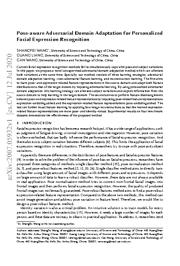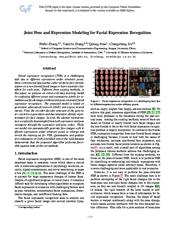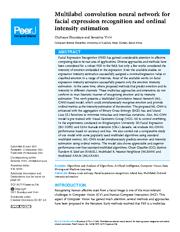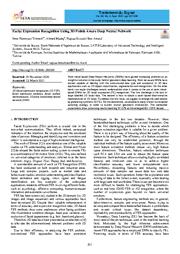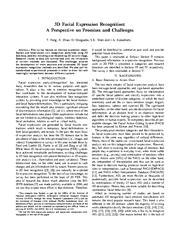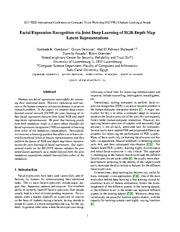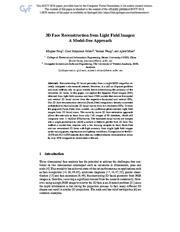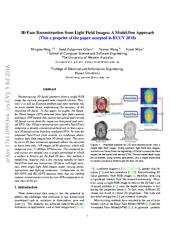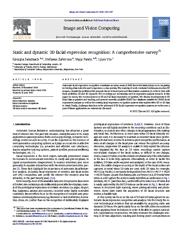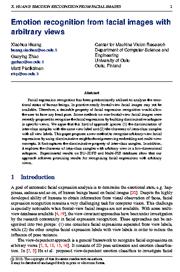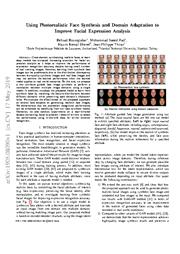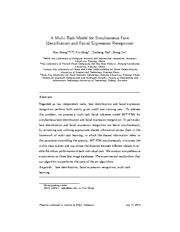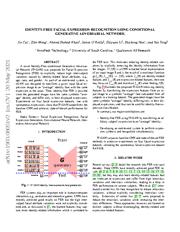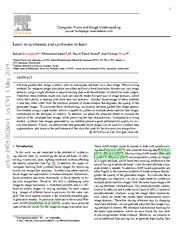A copy of this work was available on the public web and has been preserved in the Wayback Machine. The capture dates from 2020; you can also visit the original URL.
The file type is application/pdf.
Filters
Pose-aware Adversarial Domain Adaptation for Personalized Facial Expression Recognition
[article]
2020
arXiv
pre-print
Experimental results on four benchmark datasets demonstrate the effectiveness of the proposed method. ...
Current facial expression recognition methods fail to simultaneously cope with pose and subject variations. ...
) pan angles on the BU-3DFE dataset. ...
arXiv:2007.05932v1
fatcat:atgcinzkjrefpog4pb43h3ldhy
Joint Pose and Expression Modeling for Facial Expression Recognition
2018
2018 IEEE/CVF Conference on Computer Vision and Pattern Recognition
Second, the identity representation is explicitly disentangled from both expression and pose variations through the expression and pose codes. ...
Quantitative and qualitative evaluations on both controlled and in-the-wild datasets demonstrate that the proposed algorithm performs favorably against state-of-the-art methods. ...
the average recognition accuracy with state-of-the-art methods for the FER on the BU-3DFE dataset. ...
doi:10.1109/cvpr.2018.00354
dblp:conf/cvpr/ZhangZMX18
fatcat:bczfheuyg5gctnljsc2falnqqy
Multilabel convolution neural network for facial expression recognition and ordinal intensity estimation
2021
PeerJ Computer Science
In the experiments conducted on Binghampton University 3D Facial Expression (BU-3DFE) and Cohn Kanade extension (CK+) datasets, we evaluate ML-CNN's performance based on accuracy and loss. ...
Most of the available works on facial expression intensity estimation successfully present only the emotion intensity estimation. ...
Here, we evaluate the system performance on both BU-3DFE and CK+ datasets. ...
doi:10.7717/peerj-cs.736
pmid:34909462
pmcid:PMC8641570
fatcat:jsv3tmfejfadxdzc7umux4qal4
Facial Expression Recognition Using 3D Points Aware Deep Neural Network
2021
Traitement du signal
The conducted experiments show promising results reaching 97.23% on the enlarged BU-3DFE dataset. ...
On the other hand, two major challenges remain understudied when it comes to the use of point cloud-based DNNs for 3D facial expression (FE) recognition. ...
On the other hand, in our approach we exploit the four different levels of BU-3DFE, which improves the recognition of weak expressions. ...
doi:10.18280/ts.380209
fatcat:nhofxsbcarheflnbw2425sh3em
3D facial expression recognition: A perspective on promises and challenges
2011
Face and Gesture 2011
The challenges towards the development of more accurate and automated 3D facial expression recognition methods are identified. ...
This survey focuses on discrete expression classification and facial action unit recognition performed using 3D face data, possibly including a corresponding 2D texture image. ...
All statements of fact, opinion or conclusions contained herein are those of the authors and should not be construed as representing the official views or policies of IARPA, the ODNI, the U.S. ...
doi:10.1109/fg.2011.5771466
dblp:conf/fgr/FangZOSK11
fatcat:x3jpeexcxbfvzo4sbfexi6if2q
Facial Expression Recognition via Joint Deep Learning of RGB-Depth Map Latent Representations
2017
2017 IEEE International Conference on Computer Vision Workshops (ICCVW)
Our experimental results on the BU-3DFE dataset validate the proposed fusion approach, as a model learned from the joint modalities outperforms models learned from either of the modalities. ...
We posit that learning jointly from both modalities result in a more robust classifier for facial expression recognition (FER) as opposed to learning from either of the modalities independently. ...
This work was also supported by the European Union's Horizon 2020 research and innovation project STARR under grant agreement No.689947. ...
doi:10.1109/iccvw.2017.374
dblp:conf/iccvw/OyedotunDSAO17
fatcat:2ukbhdjtvjf65i2hig3kqigbay
3D Face Reconstruction from Light Field Images: A Model-Free Approach
[chapter]
2018
Lecture Notes in Computer Science
Comparison on the BU-3DFE and BU-4DFE datasets show that our method reduces reconstruction errors by over 20% compared to recent state of the art. ...
However, it is still an ill-posed problem and most methods rely on prior models hence undermining the accuracy of the recovered 3D faces. ...
Acknowledgments This research was partly supported by National Natural Science Foundation of China (NO.61401046, 61733004) and Australian Research Council (ARC) Discovery grant DP160101458. ...
doi:10.1007/978-3-030-01249-6_31
fatcat:5qajm25cjnautmbrqw2lrbeph4
3D Face Reconstruction from Light Field Images: A Model-free Approach
[article]
2018
arXiv
pre-print
Comparison on the BU-3DFE and BU-4DFE datasets show that our method reduces reconstruction errors by over 20% compared to recent state of the art. ...
However, it is still an ill-posed problem and most methods rely on prior models hence undermining the accuracy of the recovered 3D faces. ...
The Titan Xp used for this research was donated by NVIDIA Corporation. ...
arXiv:1711.05953v4
fatcat:zkdce2brhrflfctmlo2jud7tvm
3D Approaches and Challenges in Facial Expression Recognition Algorithms—A Literature Review
2019
Applied Sciences
Solutions based on 2D models are not entirely satisfactory for real-world applications, as they present some problems of pose variations and illumination related to the nature of the data. ...
In recent years, facial expression analysis and recognition (FER) have emerged as an active research topic with applications in several different areas, including the human-computer interaction domain. ...
Most of the works found in literature make use of the landmarks manually labeled on the BU-3DFE or Bosphorus dataset. ...
doi:10.3390/app9183904
fatcat:dvbywdwqyvhp7l5ucac6d5bpue
Static and dynamic 3D facial expression recognition: A comprehensive survey
2012
Image and Vision Computing
In this paper we survey the recent advances in 3D and 4D facial expression recognition. ...
The majority of work conducted in this area involves 2D imagery, despite the problems this presents due to inherent pose and illumination variations. ...
This method achieved an average expression recognition rate of 81.2% on the BU-3DFE database. ...
doi:10.1016/j.imavis.2012.06.005
fatcat:oqijx33myrbmzcbbywrysbezie
Emotion recognition from facial images with arbitrary views
2013
Procedings of the British Machine Vision Conference 2013
Experimental results on BU-3DFE and Multi-PIE databases show that our approach achieves promising results for recognizing facial expressions with arbitrary views. c ...
Therefore, a desirable property of facial expression recognition would allow the user to have any head pose. ...
BU-3DFE dataset experiments In the BU-3DFE database, there are 100 subjects with 3D models and face images. ...
doi:10.5244/c.27.76
dblp:conf/bmvc/HuangZP13
fatcat:zfkuysudxraxhpuylhidndgcdy
Using Photorealistic Face Synthesis and Domain Adaptation to Improve Facial Expression Analysis
[article]
2019
arXiv
pre-print
Moreover, we also conduct experiments on a near-infrared dataset containing facial expression videos of drivers to assess the performance using in-the-wild data for driver emotion recognition. ...
We evaluate the effectiveness of the proposed approach on several face datasets on generating realistic face images. ...
BU-3DFE dataset
Fig. 8 : 8 Impact of the amount of training synthetic images on performance in terms of expression recognition accuracy (left). ...
arXiv:1905.08090v1
fatcat:ehsfrdnq4bcmxk5fd25ilm5ysq
A multi-task model for simultaneous face identification and facial expression recognition
2016
Neurocomputing
In particular, face identification and facial expression recognition are learnt simultaneously by extracting and utilizing appropriate shared information across them in the framework of multi-task learning ...
To address this problem, we propose a multi-task facial inference model (MT-FIM) for simultaneous face identification and facial expression recognition. ...
images of one person on BU-3DFE facial expression database
375 To evaluate more comprehensively the performance of MT-FIM, we joint three facial expression databases of the Cohn-Kanade, BU-3DFE Facial ...
doi:10.1016/j.neucom.2015.06.079
fatcat:2peg72k6ofhanek43bwmr4p44u
Identity-Free Facial Expression Recognition using conditional Generative Adversarial Network
[article]
2021
arXiv
pre-print
Experiments on four facial expression datasets, one with spontaneous expressions, show that IF-GAN outperforms the baseline CNN and achieves state-of-the-art performance for FER. ...
Then, identity-free FER is possible since the generated images have the same synthetic "average" identity and differ only in their displayed expressions. ...
synthesis and recognition simultaneously. ...
arXiv:1903.08051v2
fatcat:hqcnt6aat5espffq7hrxiyxtl4
Learn to synthesize and synthesize to learn
[article]
2019
arXiv
pre-print
Finally, we demonstrate that generated facial images can be used for synthetic data augmentation, and improve the performance of the classifier used for facial expression recognition. ...
Another disadvantage of these methods is that they often suffer from the common problem of mode collapse that degrades the quality of the generated images. ...
Fig. 10 : 10 Fig.10: Visualization of some hidden units in the encoder of LSSL trained on the BU-3DFE dataset Yin et al. (2006) . ...
arXiv:1905.00286v1
fatcat:xjpgodrpjjcidm7yugogsd7av4
« Previous
Showing results 1 — 15 out of 105 results

